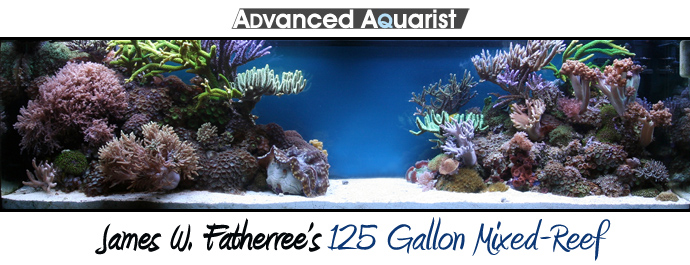
While water flow is great, there are few pumps, and they aren’t eyesores. Really, you can only see one when looking at the aquarium and it’s not particularly noticeable, which I like very much. I’m not using any “regular” actinic 420nm bulbs, and I don’t use a bunch of additives, either. In fact, the only additive that goes in is kalkwasser. There is no skimmer. Well, actually there is one in the sump, but I haven’t used it in years. Still, I’ve had no algae problems, and there’s almost none in the aquarium at this time. Sponge growth is like nothing I’ve had before, with much of the surface on the under/back sides of rocks being nearly covered. And, for the first time, I have copious amounts of zooplankton thriving in an aquarium. Lastly, with the exception of a single red open brain coral, every cnidarian in the aquarium originated from frags/cuttings taken from other specimens. I’ve easily produced over a hundred frags/cuttings for my own livestock, too. So, read on and see what my somewhat different recipe for success has been.
https://www.youtube.com/watch?v=26y3dCsbGMA&list=PL4yBAcvG5KaBAwoLF0K_X7w5A8RGSOJUq&index=24
Livestock
Over the last couple of years a lot of things have been placed in and taken out of the aquarium, seeing what works and what doesn’t. I’ve had problems with some things, and great success with others. So, what I have now is the result of quite a bit of trial and error. I’ll discuss some of the stocking problems I’ve had later, but here’s the list of what’s in the aquarium now.
Fishes
- One yellow tang, Zebrasoma flavescens.
- One scopas tang, Zebrasoma scopas.
- One two spot tang, Ctenochaetus binotatus.
- One tomini tang, Ctenochaetus tominiensis.
- One unidentified tang, Ctenochaetus sp.
- One foxface rabbitfish, Siganus vulpinus.
- One yellow coris wrasse, Halichoeres chrysus.
- One Randall’s shrimp goby, Amblyeleotris randalli.
In addition to these permanent residents, I have a pair of ocellaris clownfishes ( Amphiprion ocellaris ) in an aquarium system at school that sometimes comes home with me for the summer. They’re rather easy to catch, so I’ll bring them home for a while and take them back to school when classes start.
I also had a wonderful cherub angel ( Centropyge argi ) for a couple of years, but it disappeared recently despite being very healthy. I have no idea what happened to it… Also, before getting the Randall’s shrimp goby, I had a pair of pink bar/aurora gobies ( Amblyeleotris aurora ) living with a Randall’s pistol shrimp, but both gobies ended up jumping out of the aquarium.
https://www.youtube.com/watch?v=U7vZkgLmFvg&list=PL4yBAcvG5KaBAwoLF0K_X7w5A8RGSOJUq&index=5
Invertebrates
- One Randall’s pistol shrimp, Alpheus randalli , that lives with the goby.
- One skunk cleaner shrimp, Lysmata amboinensis .
- One peppermint shrimp, Lysmata sp.
- One bumble bee shrimp, Gnathophyllum americanum .
- Approximately twenty blue leg hermit crabs, Clibanarius tricolor .
- One scarlet hermit crab, Paguristes cadenati .
- One halloween hermit crab, Ciliopagurus strigatus .
- One zebra hermit crab, Calcinus laevimanus .
- Two porcelain crabs, Petrolisthes sp.
- One sand stirrer star, Archaster typicus .
- Dozens of asterina stars, Asterina sp.
- Hundreds of small unidentified brittle stars.
- One derasa clam, Tridacna derasa.
- Six astrea snails, Astraea tecta .
- Three zebra turbo snails, Turbo sp.
- Approximately twenty unidentified vermetid snails.
- Approximately six species of unidentified sponges.
- Dozens of small unidentified feather duster worms.
- Dozens of tentacled tube worms, Phyllochaetopterus sp.
- Hundreds of small unidentified bristle worms.
- Hundreds (thousands?) of unidentified zooplankters.
https://www.youtube.com/watch?v=dJ6z_Sg_lRc&list=PL4yBAcvG5KaBAwoLF0K_X7w5A8RGSOJUq&index=36
Cnidarians
- Three colonies of green slimer acropora, Acropora. yongei .
- Two colonies of blue/green tort acropora, Acropora tortuosa .
- Two colonies of green milli acropora, Acropora sp.
- Two colonies of ORA Bellina acropora, Acropora sp.
- One colony of deepwater acropora, Acropora suharsonoi .
- One colony of bushy acropora, Acropora sp.
- One red open brain, Trachyphyllia geoffroyi .
- Three varieties of toadstool coral, Sarcophyton sp.
- One yellow toadstool coral, Sarcophyton elegans .
- One devil’s hand coral, Lobophytum pauciflorum .
- Two finger leather corals, Sinularia sp.
- Two green finger leather corals, Sinularia sp.
- Two clusters of 2 species of tree leather coral, Nepthea sp. and Capnella sp.
- One cluster of clove polyps, Clavularia sp.
- Several clusters of 2 species of pulsing xenia, Xenia sp.
- Several clusters of 2 species of non-pulsing xenia, Xenia sp.
- Several clusters of blue xenia, Cespitularia erecta .
- Several clusters of 3 varieties of mushroom anemone, Discosoma sp.
- One cluster of fuzzy mushrooms, Discosoma sp.
- One cluster of hairy mushrooms, Rhodactis indosinensis .
- Two clusters of ricordea mushrooms, Ricordea yuma .
- Several patches of 4 varieties of star polyp, Pachyclavularia sp.
- Several patches of 4 varieties of zooanthid, Zoanthus sp.
- Three patches of yellow polyps, Parazoanthus gracilis .
- Hundreds of jasmine polyps, Knopia sp.
- Hundreds of 24 visually distinct varieties of button polyps, Protopalythoa sp.
Tank and Equipment
I’ve had numerous aquariums over the years, big and small, but I’ve found a six-foot 125 gallon to be my favorite size. It’s plenty big for housing lots of livestock, but not so large as to take up too much space in my current house, or require more than a standard 32 gallon trashcan of R.O. water for water changes. Of course, I also prefer reef-ready/drilled tanks with a sump so that the water level in the main tank stays the same regardless of how often I add top-off water to replace what evaporates. So, several years ago I purchased an All-Glass 125 gallon reef-ready tank (72″L x 18″W x 22″H). This tank originally had an overflow box in each corner, but I removed the box at the right end of the tank with a razor blade and closed off the plumbing holes in the bottom pane of glass. It just wasn’t necessary, and removing it freed up a significant amount of space. Anyway, here’s the list of all the other equipment I’m currently using:
An All-Glass 55 gallon tank (48″L x 13″W x 21″H) is used as a sump under the main tank for the collection of detritus and holding of chemical filter media. Again, I also ran a skimmer in the sump in the past, but no longer do so. I just haven’t bothered to remove it, and figure it might be needed one day if some unforeseen water quality problem arises.
An Aquactinics Constellation T-5 fixture is used for lighting. This low-profile fixture holds 14 three-foot 39w T-5 HO bulbs (7 over each half of the six-foot tank) with an individual reflector for each bulb, and has three power switches.
However, for the last couple of years I’ve been using only 10 bulbs, with 3 Wave Point Super Blue Wave Actinic 460nm bulbs and 2 Wave Point Sun Wave 12,000K Super Daylight bulbs over each half of the tank. All 6 Super Blue Wave bulbs are on one timer and are turned on for 12 hours per day. The 4 Sun Wave bulbs are on another timer and are turned on for 10 hours a day, switching on one hour after the Super Blue Wave bulbs come on, and switching off one hour before the Super Blue Wave bulbs turn off. Again, no “regular” actinic 420nm bulbs are used. This lighting produces an overall color that I really like, which makes the colors of corals and such look good, and the 460nm bulbs are significantly brighter than the 420nm bulbs I’ve used, too.

While this fixture can run 14 bulbs, I’ve pulled the bulbs from the front and back, done some rearranging, and only use 10 now.
A Taam Rio+ 2100 37w submersible pump serves as the return pump from the sump, with the twin-outlet return being near the top-left front corner of the tank (at position #1 in the photo below).
A Hagen Fluval AquaClear 70 20w powerhead is located at the top-left-rear corner of the tank (at #2, behind the corals), next to the remaining overflow box, and pointed straight across the back of the tank towards the top-right-rear corner of the tank. I positioned the rock and corals so that there’s a gap of several inches behind them near the top of the tank, leaving an unobstructed path for water flow across the back of the tank.
A Reef Octopus Diablo 50w DC external pump is used as a closed-loop circulation pump, with the screened intake being next to the AquaClear 70 powerhead at the top-left-rear of the tank. The return is at the top-right-rear of the tank (at #3) and is pointed straight across the back of the tank towards the AquaClear 70 powerhead.
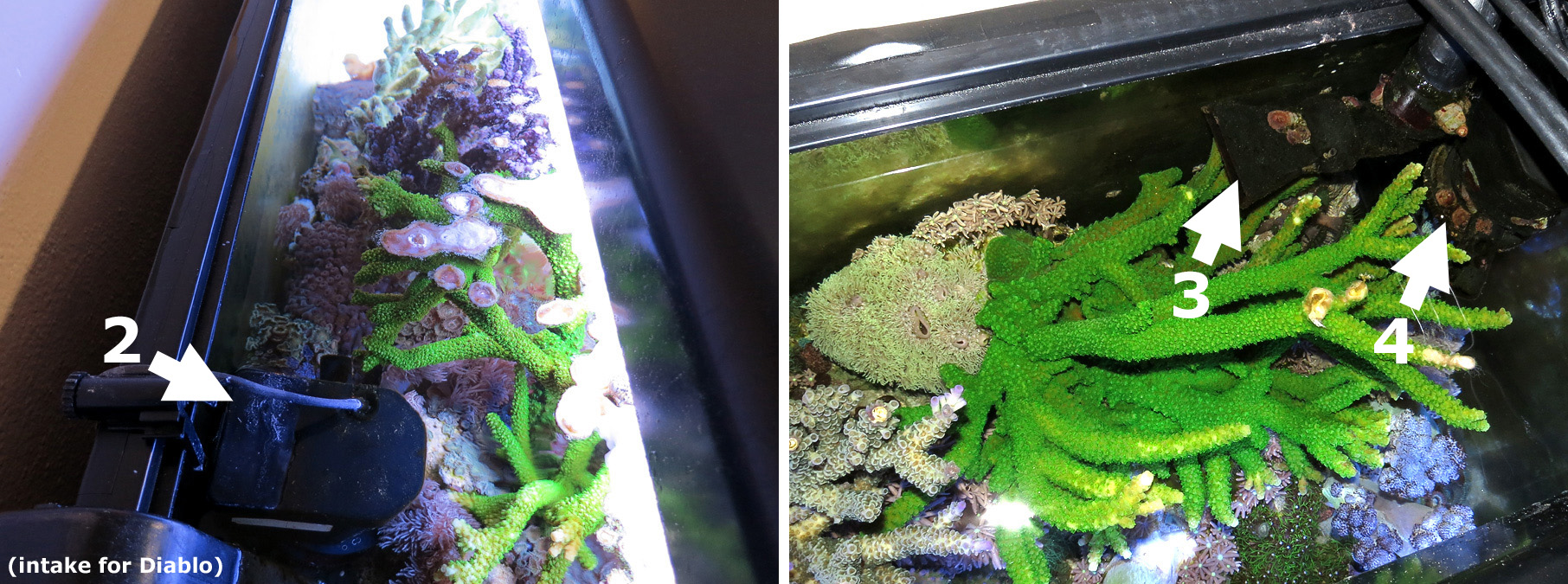
The numbered arrows indicate where the pumps/returns are placed. Note the open flow path across the back of the tank, behind the stony corals.
It’s randomly (manually) turned on for a few hours a week at most (sometimes not at all), and when on, it’s almost always run at only half power (approximately 25w). Again, the return is pointed towards the always-running AquaClear 70 powerhead at the opposite end of the tank, and when both are on and “fighting” against each other, a great amount of turbulent, swirling flow is generated in the open area in the middle of the tank, which then affects almost all parts of the aquarium. This stirs up detritus that accumulates in some areas of normally lower flow, and really gets the soft corals, etc. moving around a lot.
Last, is a Hagen Fluval AquaClear 50 12w powerhead, located at the top-right-rear corner of the tank (at #4), and pointed towards the front-middle of the tank.
Note that the devices above are the only power-consuming items in use. Not only is there no skimmer running, there’s no chemical media reactor, no electronic controller, no chiller, etc. In other words, less electricity is used, there’s less equipment to clean/maintain, and there are fewer things that can potentially malfunction.
Power Consumption, Past and Present
A few years ago I was using a lighting fixture housing three 175w metal halide bulbs and two 165w T-12 VHO bulbs. I also used the same 37w pump for the sump return, two 20w powerheads, a 90w closed-loop external pump, and a 20w submersible pump running an in-sump skimmer. Total power consumption with everything on was approximately 1,042w, with 855w being used by the lighting and 187w being used by the pumps.
Now when everything is on, total power consumption is approximately 484w, with 390w being used by the lighting and the remaining 94w being used by the pumps. At night with the lighting and Diablo pump turned off, total power consumption is only 69w. That’s a 54% reduction in total power consumption when everything is on, and a 63% reduction at night.
Maintenance
When it comes to maintenance, I’ve made an effort to keep things as simple as possible. I want a beautiful aquarium that I can enjoy, rather than a headache that I have to work on all the time. So, here’s the routine:
I feed the fishes a mix of Ocean Nutrition Prime Reef and Spirulina flake foods, typically two or three times a day. However, there are times when it’s only once a day, and every once in a while it’s no times per day (when I’m away from home). A couple of times a week I also toss in a pinch of Ocean Nutrition Formula One sinking pellets and/or New Life Spectrum Marine Fish Formula sinking pellets. The fishes eat most of them, but the peppermint shrimp and skunk cleaner shrimp oftentimes grab a few, too. About once a week I also use a long piece of rigid airline tubing to target feed the Randall’s pistol shrimp, with the Randall’s shrimp goby taking some of them, as well. All of the fishes are very healthy and nice and thick, and the shrimps are fine and apparently find plenty of other stuff to eat, as I really don’t see them eat much of the food I provide.
On occasion, I also feed the corals and such. I put some tank water in a small glass, set it on top of the lighting fixture and then drop in a few Sally’s San Francisco Bay frozen cyclops cubes, brine shrimp cubes, and omega brine shrimp cubes. Once they’ve completely thawed, I stir up everything, turn off all the pumps, move the fixture, and use a turkey baster to target feed the things that I know will take it (button polyps do, but zoanthids don’t, etc.). I used to do this about once a week when I was still adding things to the aquarium and trying to get good coverage over all of the rocks. However, I only do this once a month or so now that almost all of the visible rock has been grown over, typically a day or two before I do a water change.
In case you’re wondering, nutrient levels don’t seem to be a problem, regardless of how much food I put in the aquarium. While it wasn’t the case early on, now there are hundreds of tiny mouths covering the rocks, and any bits of food that aren’t eaten by the fishes, or caught by the corals when I target feed them, are most likely caught and eaten by something, somewhere in the aquarium anyway. Same goes for any dissolved nutrients, which are absorbed by many such things. The corals themselves are a nutrient control mechanism.
Anyway, usually every week to ten days I use E.S.V. or Two Little Fishies calcium hydroxide/kalkwasser to keep calcium levels up. I add it as a slurry by putting a heaping tablespoon of power into a plastic container and then adding a gallon of R.O. water, which is then fed to the aquarium by a length of airline tubing with a flow controller taken from an I.V. line. I attached this to the container by drilling a hole in the bottom corner and then screwing in a brass hose nipple for the tubing. Flow of the slurry is reduced to a slow drip so that it takes at least a couple of hours for the container to drain, with it dripping into the area over the sump return. So, it gets mixed into the aquarium’s water quickly and thoroughly.
As was the case with feeding the corals, I used to do this more often when I was trying to get the stony corals to grow as fast as possible. Now they’re growing out of the water and spreading laterally too, so I’ve cut back. I haven’t actually tested calcium levels (or anything else) in a couple of years, but just keep an eye on things. As long as everything looks good, I see some coral growth, and new shell material is being added by my derasa clam, I don’t feel the need to do water tests or make any changes to the routine.
For many years I also used Kent Tech I, and would see an apparent positive effect in the form of greater expansion and more rapid growth/reproduction of soft corals and such. However, I started adding it less and less frequently and completely stopped using it some time ago. Again, I no longer want greater expansion or more rapid growth/reproduction of anything in the aquarium. I don’t use any other additives, either. Nothing goes in except food, kalkwasser, and water, which is next.
With an occasional exception when life gets in the way, I do monthly water changes using R.O. water and Instant Ocean Reef Crystals. I put approximately 16 cups of salt mix in a covered 32 gallon trashcan on the back deck and then fill it with R.O. water. I also put a powerhead in the trashcan to stir things up. I usually let it mix overnight, and the salinity is usually right in the range of 1.023-1.025 when measured as density using a swing-arm hydrometer. Note that 32 gallons is just right for a 25% water change when adding the volumes of water in the aquarium and sump, minus a few gallons for the rock and corals.
I use a 40 foot length of vinyl tubing with a Taam Rio+ 2100 submersible pump on one end and a U-tube directional return on the other to do the changes. Once the new water is ready, I turn off all the pumps and lights, place a second 32 gallon trashcan next to the aquarium, and use the hose/pump to quickly drain enough water from the aquarium to fill the empty can. The hose is then used to pump the new water from the trashcan outside into the aquarium. By using two trashcans, I never have volume issues during the process. Then, once the aquarium is refilled, I turn everything back on, turn the Diablo pump on full blast for a while, and use the hose/pump to drain the old water from the trashcan next to the aquarium into the bathtub. Yes, I have to move the hose and trashcans around, but the whole process is really pretty easy and takes no more than a half-hour.
After each water change is completed, I put approximately two to three cups of E.S.V. or Two Little Fishies HydroCarbon2 granular activated carbon and one cup of Two Little Fishies Phosban into a mesh bag. This is rinsed very well in the kitchen sink and then put in the sump in an open-top plastic box placed directly under the drain/down-pipe from the aquarium. Water thus flows around/through the mesh bag at all times, and this is apparently working well enough to forgo the use of a skimmer and any sort of reactor chamber.
I also change the bulbs about once a year, sometimes a bit longer. And, about once a year I use the hose/pump combo to suck up much of the detritus in the sump instead of taking all the water from the aquarium when doing a water change. There are so many worms and so much zooplankton in the sump that I don’t want to actually suck it dry, so I just slowly move the pump intake around the bottom of the sump and get most, but not all, of the detritus. This always leaves some critters behind.
Other than that, the only other chore is keeping the corals and such in check. All of the branching stony corals and larger soft corals have to be trimmed regularly. In fact, I’ve had to pull out whole soft corals at times, as they just got too big/numerous. I also pull out a good bit of xenia from time to time as it reproduces quickly and springs up all over the place.
I’ve been able to trade frags/cuttings for supplies at a couple of local shops, and don’t think I’ve paid for any supplies (other than a few bulbs) for a long time. I know that last summer I went snipper crazy one day and made 54 frags, some of which were pretty big, from the stony corals alone. So, I think a conservative estimate would be over one hundred frags/cuttings produced over the last couple of years, and the aquarium still looks “full”.
Oh, and I clean the microalgae off the glass every few days using a magnetic cleaner, of course.
Problems
Okay, it isn’t all perfect, and I’ve had some problems/issues. So, here they are, in no particular order:
When I decided to pretty much completely re-do this aquarium as a mixed-reef and first got it going, I didn’t need the Diablo closed-loop circulation pump. However, as things grew and there were more and more branches sticking up into the water column, water movement was reduced by the drag all of these created. So I added the Diablo pump for some extra flow from time to time. While everything is generally fine without it, detritus accumulates visibly in the bottom left corner of the aquarium unless I turn on the Diablo for a while. From time to time, I also use the magnetic glass cleaner to stir up everything in the same corner while the pump is on, which really gets the sand cleaned up.
Occasionally, and with no apparent connection to anything I’m doing, a translucent film develops on the water’s surface. I don’t know what it is or where it comes from, but at least it’s easy to get rid of. As the return from the Diablo is pointed across the back of the tank towards the AquaClear 70 powerhead and overflow box at the opposite end, I can turn the powerhead off and turn the Diablo up to full blast for a few hours. This literally blasts the film into the grate of the overflow box, and into the sump it goes. I don’t know what happens to it then, but it typically doesn’t comes back for weeks at a time.
When I was adding calcium more often, there was a lot more coralline algae growing in the aquarium. However, much of it has slowly disappeared over the last year or so. Fortunately, most of the lighted rock is covered by other things, while unlit surfaces have been largely overgrown by sponges. And, I don’t have to scrape coralline algae off the glass any more, either. So, in some ways this isn’t a problem after all.
Several of the stony corals have grown up to the water’s surface and have produced little tables at the ends of their exposed branches. This doesn’t seem to be any problem for the corals, except that the tables are increasing in size by growing laterally, and are increasingly shading things underneath them. I guess at some point, probably soon, I’ll have to carefully trim these down with some snips. Still, I imagine there are some folks that would like to give me a kick in the rear for bringing up too much coral growth as a problem.
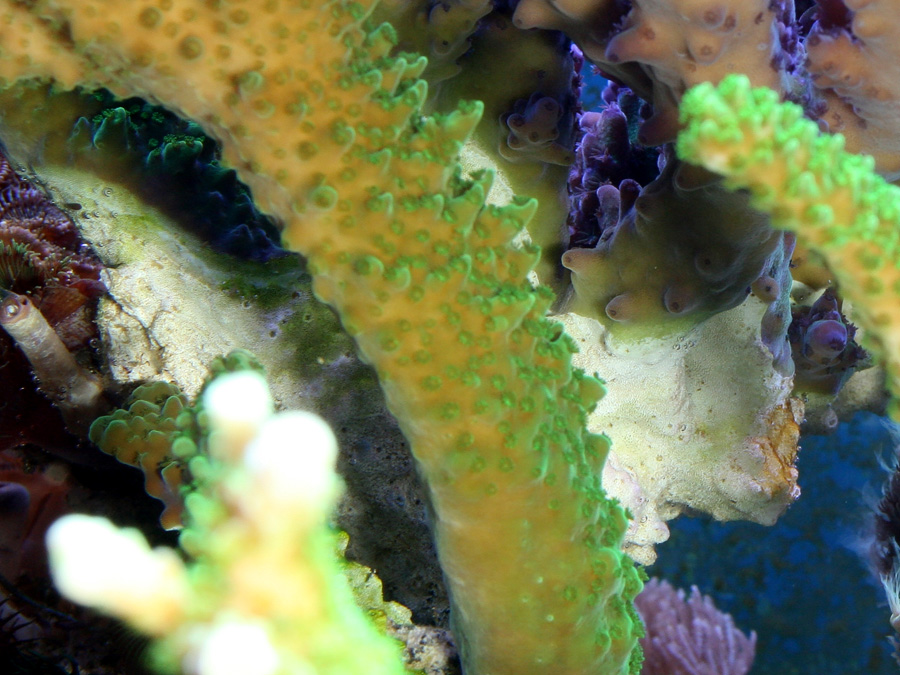
The base of this colony is heavily shaded and has lost some tissue. It’s only lit up in the picture because I used a flash.
Anyway, I recently noticed that two of the largest stony coral colonies, one of the green slimers and one of the torts, were losing tissue at their bases. They’ve grown to a large enough size that their bases are heavily shaded at this point, and I assume the tissue recession is the result. I watched them very carefully for a couple of weeks, but it finally stopped and hasn’t progressed any further in a few weeks. I imagine the areas of naked skeleton will soon enough be covered by button polyps and such, but these two corals seem to be very resistant to having their living tissue succumb to overgrowth by other things. We’ll see what happens over the coming months…
Lastly, I’ve had some compatibility issues, which shouldn’t be a surprise. For example, at one point I was about to tear out everything on the right end of the aquarium just to get rid of the fast-growing anthelia I had added. Don’t add it unless it’s all you want! I’ve also had and still have a few corals that refuse to grow at all, no matter where I put them in the aquarium. A couple of the fishes have started to have relationship problems, too. However, overall I think things have gone relatively smoothly considering the diversity of life in the aquarium. Regardless, I’ll be doing a second article on this aquarium, which will focus specifically on compatibilities, what can/can’t touch what, what grows fast and what doesn’t, etc. So, keep an eye out for that one if you want a lot of information about mixing various fishes and corals your aquarium.
Final Comment
To finish up I have to say, no, I haven’t accepted any sort of favors, payments, or free samples of the products I mentioned by name. The pumps may or may not be the best for your situation, the foods may or may not be the most nutritious for your livestock, etc., and I’m certainly not suggesting you go out and buy something just because I use it (or stop using something because I don’t use it). I simply use what has worked for me over the long-term and is readily available at the local fish stores I do most all of my business with. Again, I often trade frags/cuttings for supplies, and take whatever they’ve got on hand as long as I know the product and have used it with success. You may be able to find something better (and/or cheaper) than what I use, but in my opinion, you really can’t go wrong with these products, either.

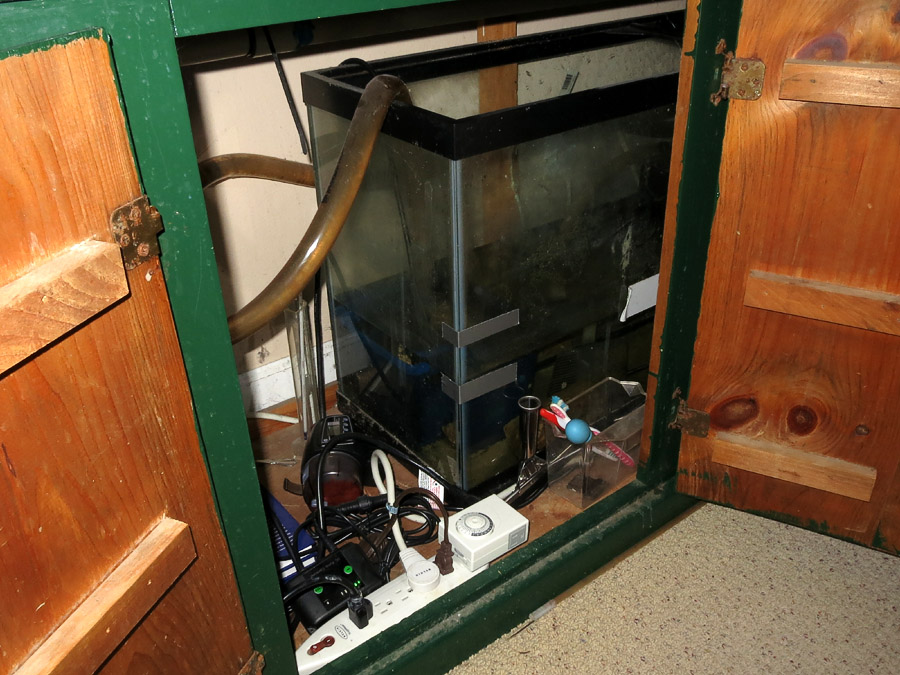
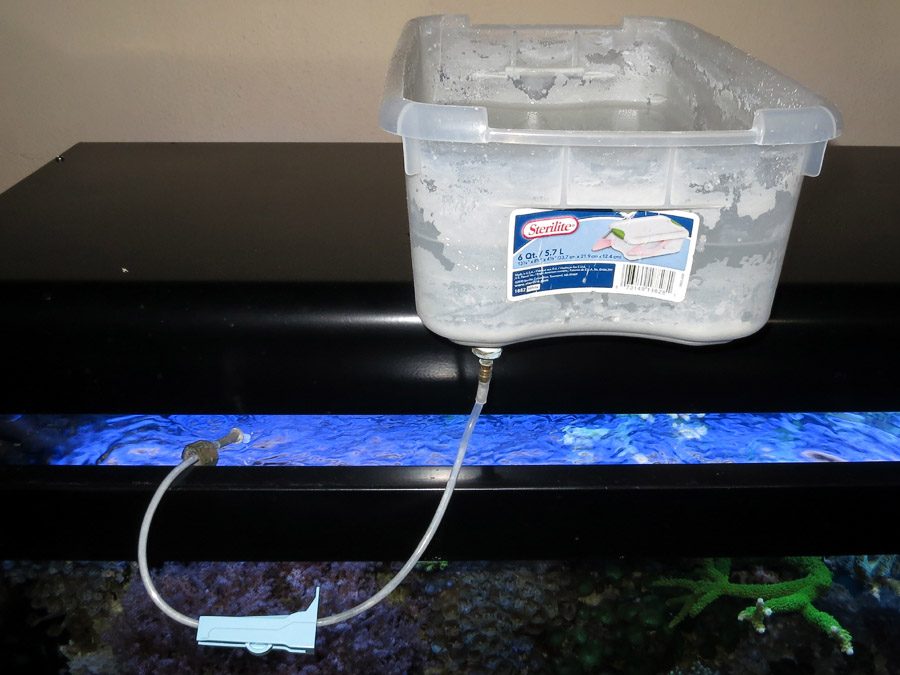
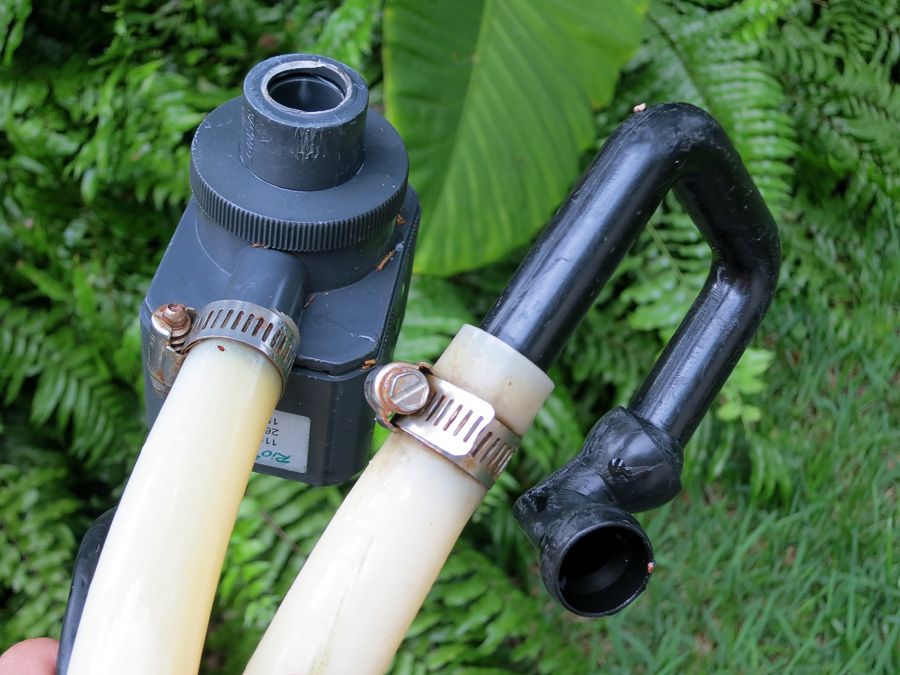

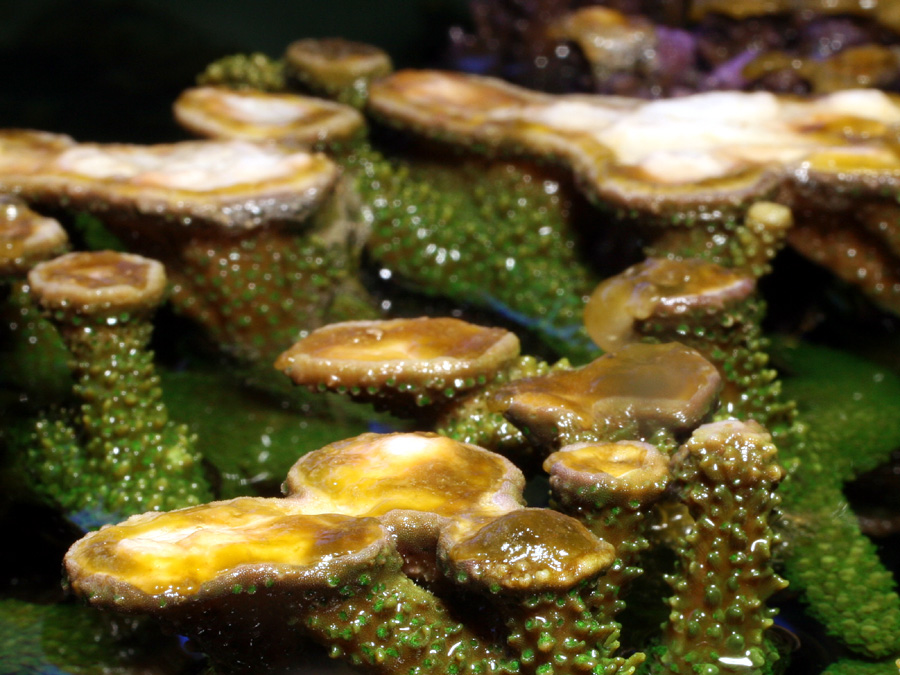


hi im johnny iminterested in a 125 gallon tank with th stand and the screen lid how much it cost